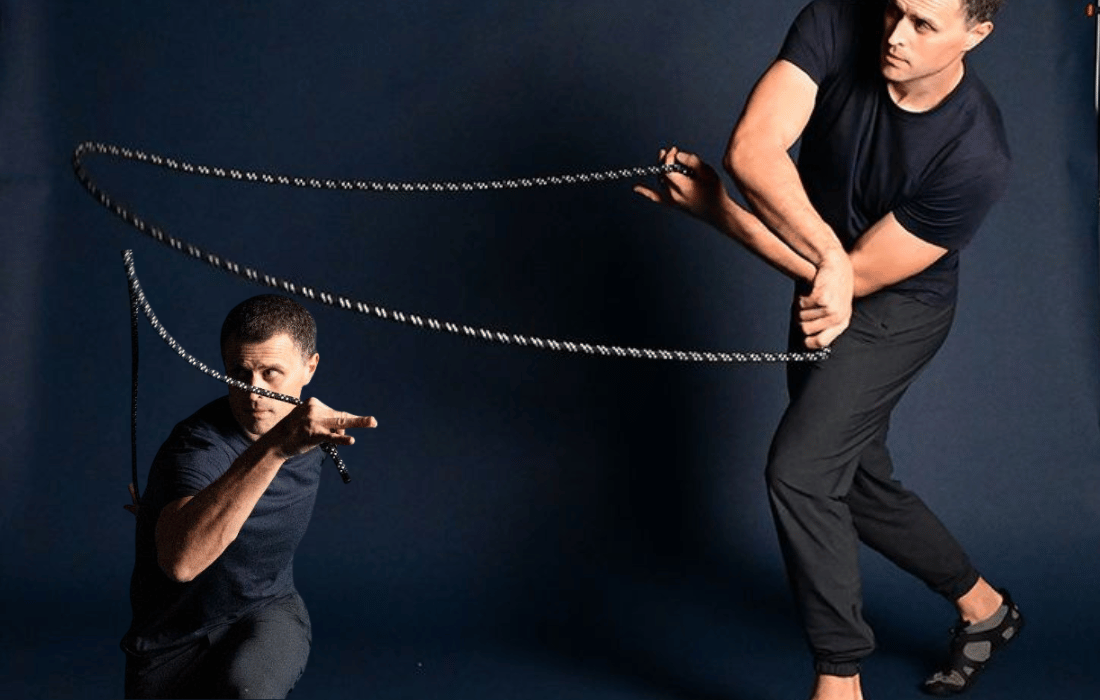In the ever-evolving world of fitness, there’s always a new tool or technique claiming to revolutionize your training. But few can match the unique combination of fluidity, athletic intelligence, and scalability found in rope flow training. With origins rooted in movement patterns that our bodies have used for millennia, this workout method offers a fresh, dynamic approach to exercise that blends cardiovascular endurance, coordination, and strength into one harmonious practice.
In this guide, we’ll dive deep into the origin of rope flow, its intended use, its numerous benefits, and how athletes of all levels can begin incorporating it into their training regimen.
The Origins of Rope Flow Training

Rope flow training, as a formalized fitness method, originated from David Weck, the creator of the WeckMethod and the RMT (Rotational Movement Training) Rope. Weck introduced the practice with the idea that the human body’s natural movement patterns, such as walking, running, and throwing, rely heavily on rotational movements. By harnessing this rotation in training, rope flow allows athletes to move more efficiently and fluidly in their respective sports.
However, the principles behind rope flow date back to ancient practices found in martial arts, dance, and Tai Chi. These disciplines have long focused on circular, rhythmic movements that build coordination, core strength, and body awareness. Rope flow training takes these timeless ideas and integrates them into a modern, scalable fitness practice that anyone—from elite athletes to beginners—can benefit from.
Rope Flow’s Intended Use
At its core, rope flow is about enhancing movement efficiency. It’s a tool that helps you reconnect with natural body patterns and teaches you to flow with your movements instead of resisting them. Whether you’re an athlete trying to improve your agility and coordination or someone simply looking to elevate their fitness, rope flow can be adapted to suit your goals.
Unlike jump rope training, where the emphasis is on the vertical motion of jumping, rope flow focuses on rotational movement. This makes it a powerful tool for developing better core stability, shoulder mobility, and joint strength while reducing the risk of injury. It’s a safe, low-impact form of exercise that allows users to practice complex movement patterns without the repetitive stress seen in many other forms of training.
The Benefits of Rope Flow Training
1. Scalability for All Fitness Levels
One of the most compelling aspects of rope flow is its scalability. Whether you’re a seasoned athlete or a complete beginner, you can benefit from the practice. The rope itself can vary in thickness and weight, allowing you to tailor the intensity of your training. You can start with simple movements and gradually progress to more complex patterns, making it a practice that grows with you.
Rope flow is accessible to people of all ages and fitness levels. From competitive athletes to seniors and even those with health conditions, it offers a gentle yet effective way to stay active and improve mobility.
2. Cardiovascular and Strength Training in One
Rope flow is an excellent cardio workout, increasing your heart rate and building endurance without the high-impact stress of running or jumping. Because the weighted rope offers resistance, it also provides strength benefits, particularly in the upper body, core, and legs. Over time, this combination can lead to improved overall conditioning, lean muscle development, and better stamina.
3. Enhanced Coordination and Athletic Intelligence
One of the key benefits of rope flow is its ability to improve coordination and timing. As you learn to control the rope’s movements and synchronize them with your body, you naturally develop better motor control. This carries over into sports like running, striking, throwing, and even grappling, where precise coordination is crucial.
David Weck refers to this as “downloading athletic intelligence”—by practicing rotational patterns, you’re training your brain and body to move more efficiently across various activities. Rope flow can help athletes improve their footwork, balance, and agility, which translates to better performance on the field, track, or ring.
4. Core Strength and Rotational Power
While many traditional workouts focus on static or bracing core exercises, rope flow emphasizes the rotational movements of the core. This type of movement is more natural and functional, as the body rarely moves in straight lines during sports or daily activities. By incorporating spirals, figure eights, and other flowing patterns, you’re building core strength and rotational power, which are essential for everything from sprinting to throwing a punch.
The concept of the spinal engine, first discussed by Serge Gracovetsky, highlights how the rotation of the spine drives locomotion. Rope flow taps into this principle, helping you build strength in the transverse plane, which is often neglected in traditional strength training.
5. Improved Mobility and Joint Health
Rope flow’s gentle, repetitive motions make it an excellent tool for improving joint mobility, particularly in the shoulders, hips, and spine. Unlike heavier tools like kettlebells or maces, the rope allows for high repetitions without the risk of overloading joints. This makes it a safe and effective way to enhance range of motion, strengthen connective tissues, and prevent injury.
6. Portability and Convenience
One of the practical benefits of rope flow is its portability. A rope can easily fit into a gym bag or suitcase, making it an ideal tool for those who travel frequently or prefer to work out outdoors. Whether you’re at the beach, in a park, or in your backyard, you can bring your rope and get a full workout without the need for heavy equipment or a gym membership.
7. Mental and Emotional Benefits: Stress Release and Flow State
Rope flow isn’t just about physical training—it also has profound mental and emotional benefits. The rhythmic, flowing nature of the practice can be incredibly meditative, helping to reduce stress and anxiety. The repetitive movements encourage deep, relaxed breathing, which engages the parasympathetic nervous system, promoting relaxation and recovery.
Moreover, rope flow is known to help practitioners enter a flow state—a mental state where you’re fully immersed in the activity at hand, often referred to as being “in the zone.” This state is associated with improved focus, creativity, and a sense of well-being.
How to Incorporate Rope Flow into Your Training
1. Choose the Right Rope
Before you begin, you’ll need the right tool. Rope flow ropes are typically thicker and heavier than jump ropes, which allows for better control and momentum in the rotational movements. You can purchase specialized ropes like the RMT Rope or opt for a DIY version by selecting thick polyblend rope from a hardware store.
2. Start with the Basics
If you’re new to rope flow, start with simple patterns like figure eights or drag and roll. These movements help you get accustomed to the flow of the rope and begin building coordination. Focus on maintaining a neutral spine and keeping your movements smooth and fluid. Beginners should aim for 5-10 minutes of practice per session, gradually increasing the duration as they become more comfortable with the patterns.
3. Incorporate Rope Flow into Warm-Ups
Rope flow can be an excellent addition to your warm-up routine before strength training, running, or playing sports. The gentle rotations help to warm up the shoulders, spine, and hips, while also engaging the core. Try practicing for 5 minutes before your workout to loosen up tight joints and improve range of motion.
4. Use Rope Flow for Conditioning
As you progress, you can use rope flow for more intense conditioning. Increase the speed and complexity of your patterns, incorporating spirals, crosses, and slams for a higher-intensity workout. This can be done in intervals, such as 30 seconds of high-intensity rope flow followed by 30 seconds of rest, repeated for several rounds.
5. Integrate into Sports Training
For athletes, rope flow can enhance sport-specific movements. Combat athletes can benefit from the rotational core strength and improved coordination, while runners can use rope flow to improve their gait and efficiency. Incorporate rope flow drills that mimic the movement patterns of your sport for the best results.
6. Flow as Recovery
Rope flow is also an excellent recovery tool. On rest days or after a hard workout, practice low-intensity flow to increase blood circulation, reduce muscle stiffness, and promote relaxation. The gentle, rhythmic movements can help alleviate soreness and improve flexibility, making it a great addition to your recovery routine.
Advanced Tips for Mastering Rope Flow
Focus on Symmetry: As you progress, aim to improve symmetry between your dominant and non-dominant sides. Rope flow encourages bilateral coordination, helping you move more efficiently and reducing the risk of injury caused by imbalances.
Challenge Your Patterns: Once you’ve mastered the basics, mix up your patterns by changing the direction of the rope, incorporating footwork, or adding spins and rotations. This keeps your practice engaging and helps you continue progressing.
Stay Consistent: Like any skill, mastery comes with consistent practice. Aim to practice rope flow at least 3-4 times a week for 10-20 minutes. Over time, you’ll notice improvements in your coordination, strength, and mobility.
Conclusion: The Future of Functional Fitness
Rope flow training represents a growing trend in functional fitness, where the emphasis is placed on natural movement, coordination, and efficiency. It’s a workout that can be scaled to meet the needs of anyone, whether you’re an elite athlete or just getting started on your fitness journey. By integrating rope flow into your training, you’ll unlock new levels of physical performance, mobility, and mental focus—all while having fun and moving with ease.
Whether you’re looking to build strength, improve your coordination, or just enjoy a new form of movement, rope flow training has something to offer. With its roots in ancient movement patterns and modern athletic training, this practice bridges the gap between fitness and functional movement, making it a powerful tool for enhancing overall health and well-being.







